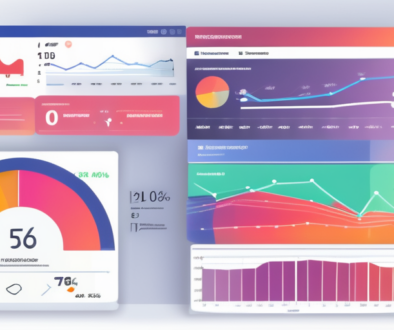Google Ads or Facebook Ads: Which Platform Is Best for Your Campaign?
In today’s digital age, online advertising has become an essential tool for businesses looking to reach their target audience. Two popular platforms for online advertising are Google Ads and Facebook Ads. While both platforms aim to help businesses promote their products or services, there are key differences in their functionality and approach. In this article, we will explore the basics of online advertising, delve into the mechanics of Google Ads and Facebook Ads, compare their costs and performance metrics, and provide guidance on choosing the right platform for your business.
Understanding the Basics of Online Advertising
Before we dive into the specifics of Google Ads and Facebook Ads, it’s important to understand the role of advertising in digital marketing. Advertising plays a vital role in generating brand awareness, driving traffic to websites, and ultimately converting leads into customers. In the digital landscape, advertising allows businesses to target specific demographics, track user behavior, and measure the effectiveness of their campaigns.
The Role of Advertising in Digital Marketing
Advertising is a strategic component of any digital marketing campaign. It helps businesses establish a presence in the competitive online space and effectively communicate their unique value proposition to potential customers. By leveraging various advertising platforms, businesses can reach their target audience at different stages of the buying journey, increasing the likelihood of engagement and conversions.
Key Concepts in Online Advertising
There are several key concepts to understand when it comes to online advertising. These concepts include ad targeting, ad formats, bidding strategies, and ad placements. Ad targeting involves defining the specific characteristics and demographics of the audience you want to reach. Ad formats refer to the different types of ads available, such as text ads, display ads, or video ads. Bidding strategies determine how much you’re willing to pay for each click or impression, while ad placements dictate where your ads appear on websites or social media platforms.
Let’s take a closer look at ad targeting. When it comes to reaching the right audience, it’s crucial to define your target market based on factors such as age, gender, location, interests, and behavior. By understanding your target audience’s preferences and habits, you can tailor your advertising messages to resonate with them and increase the chances of conversion. For example, if you’re promoting a fitness app, you might want to target individuals who have shown an interest in health and wellness, as well as those who live in areas with a high concentration of gyms and fitness centers.
Now, let’s explore ad formats in more detail. Different ad formats serve different purposes and can be used to achieve specific marketing objectives. Text ads, for instance, are concise and straightforward, making them ideal for delivering a clear call-to-action or promoting a limited-time offer. On the other hand, display ads allow for more visual creativity, enabling businesses to showcase their products or services in a visually appealing way. Video ads, with their engaging and immersive nature, are perfect for storytelling and capturing the attention of viewers. By understanding the strengths and limitations of each ad format, you can choose the most suitable one to convey your brand message effectively.
Introduction to Google Ads
Google Ads is an advertising platform created by Google that allows businesses to display text, image, and video ads on search engine result pages, websites, and mobile apps. With Google Ads, businesses can target customers who are actively searching for specific keywords relevant to their products or services.
The Mechanics of Google Ads
Google Ads operates on a pay-per-click (PPC) model, meaning businesses only pay when someone clicks on their ad. This model provides businesses with a cost-effective way to reach their target audience and maximize their return on investment. When creating a Google Ads campaign, businesses select relevant keywords that are most likely to be used by their target audience when searching for products or services. These keywords are then organized into ad groups, which help businesses to create more targeted messaging and increase the chances of their ads being shown to the right people.
Ad ranking in Google Ads is determined by a combination of factors, including bid amount, ad relevance, and landing page experience. The bid amount represents the maximum amount that a business is willing to pay for a click on their ad. Ad relevance refers to how closely the ad matches the user’s search query, while landing page experience measures the quality and relevance of the page that the user is directed to after clicking on the ad. By optimizing these factors, businesses can improve their ad ranking and increase the visibility of their ads.
Targeting and Reach in Google Ads
Google Ads offers various targeting options to help businesses reach their desired audience. One of the most powerful targeting options is geographic targeting, which allows businesses to show their ads to users in specific locations or regions. This is particularly useful for businesses that operate in specific areas or have a local customer base. By targeting their ads geographically, businesses can ensure that their ads are seen by the right people in the right locations.
In addition to geographic targeting, Google Ads also offers demographic targeting, which focuses on reaching users based on factors such as age, gender, or household income. This targeting option allows businesses to tailor their ads to specific demographic groups that are most likely to be interested in their products or services. By understanding the demographics of their target audience, businesses can create more relevant and compelling ads that resonate with their customers.
Device targeting is another important feature of Google Ads, as it allows businesses to tailor their ads specifically for desktop or mobile devices. With the increasing use of smartphones and tablets, it is essential for businesses to optimize their ads for mobile users. By creating mobile-friendly ads, businesses can ensure that their message is effectively delivered to users who are browsing on their mobile devices.
Finally, remarketing is a powerful targeting option that enables businesses to show ads to users who have previously visited their website. This allows businesses to re-engage with potential customers and remind them of their products or services. By targeting users who have already shown interest in their brand, businesses can increase the chances of conversion and drive more sales.
Introduction to Facebook Ads
Facebook Ads is a powerful advertising platform developed by Facebook that enables businesses to create and manage highly targeted ads on the popular social media platform. With over 2.8 billion monthly active users, Facebook Ads offers businesses a vast potential audience to reach.
Businesses utilizing Facebook Ads have the opportunity to tap into a diverse range of advertising options to suit their marketing objectives. From promoting brand awareness to driving website traffic and increasing conversions, Facebook Ads provide a versatile platform for businesses of all sizes to achieve their advertising goals.
How Facebook Ads Work
Facebook Ads operate on a similar pay-per-click (PPC) model as Google Ads. Advertisers create campaigns and select their target audience based on demographics, interests, behaviors, and connections. In addition to standard ads, Facebook Ads also support various ad formats, including carousel ads, video ads, and lead generation ads. By leveraging Facebook’s detailed user data, businesses can reach users with precision and relevance.
Moreover, Facebook Ads offer advanced features such as retargeting, which allows businesses to re-engage with users who have previously interacted with their website or mobile app. This strategic approach helps businesses nurture leads and guide potential customers through the sales funnel, ultimately boosting conversion rates and maximizing ROI.
Targeting and Audience Segmentation in Facebook Ads
One of the key advantages of Facebook Ads is its robust targeting capabilities. Businesses can create highly specific target audiences by layering demographic, interest, and behavior-based targeting criteria. This level of audience segmentation allows for personalized and relevant messaging, resulting in higher engagement and conversions. Additionally, Facebook Ads also offer lookalike audience targeting, which enables businesses to reach new users who exhibit similar traits and behaviors to their existing customers.
Furthermore, Facebook Ads provide detailed analytics and insights that enable businesses to track the performance of their campaigns in real-time. By monitoring key metrics such as click-through rates, conversion rates, and return on ad spend (ROAS), businesses can optimize their ad strategies for maximum effectiveness and efficiency.
Comparing Google Ads and Facebook Ads
Both Google Ads and Facebook Ads offer unique advantages and considerations for businesses. Understanding the differences between these platforms can help you make informed decisions about which platform is best suited for your advertising goals.
Google Ads, formerly known as Google AdWords, is the largest and most widely used online advertising platform in the world. It reaches billions of users through Google Search, YouTube, Gmail, and millions of other websites within the Google Display Network. With Google Ads, businesses can target potential customers based on their search queries, interests, demographics, and browsing behavior, making it a powerful tool for reaching users with high purchase intent.
Cost Differences Between Google Ads and Facebook Ads
One key difference between Google Ads and Facebook Ads is the cost structure. Google Ads operates on a bidding system, where businesses bid on keywords and pay each time a user clicks on their ad. The cost per click (CPC) can vary significantly depending on factors such as keyword competition and industry. On the other hand, Facebook Ads’ cost structure is based on a combination of factors, including the targeting parameters, bidding options, ad quality, and relevance. Both platforms offer budgeting options to help businesses control their spending.
Facebook Ads, on the other hand, leverages the vast amount of user data available on the platform to allow businesses to target specific audiences based on demographics, interests, behaviors, and connections. With over 2.8 billion monthly active users, Facebook provides a massive reach for advertisers looking to increase brand awareness and engagement.
Performance Metrics: Google Ads vs. Facebook Ads
When it comes to measuring the performance of your advertising campaigns, both Google Ads and Facebook Ads provide valuable metrics and insights. Google Ads offers metrics such as click-through rate (CTR), conversion rate, average cost per click (CPC), and return on investment (ROI). Facebook Ads provides metrics like engagement rate, reach, frequency, and social actions. The choice of which metrics to focus on will depend on your advertising goals and overall marketing strategy.
Google Ads’ conversion tracking allows businesses to track the actions users take after clicking on an ad, providing valuable data on the effectiveness of their campaigns. Facebook Ads, on the other hand, offers detailed insights into audience engagement, allowing businesses to see how users interact with their ads through likes, comments, shares, and other actions.
Choosing the Right Platform for Your Business
When considering whether to use Google Ads or Facebook Ads for your business, there are a few factors to take into account.
Factors to Consider When Choosing an Advertising Platform
Firstly, you should consider your target audience and their online behavior. Are they more likely to search for products or services on Google, or do they spend a significant amount of time on social media platforms like Facebook? Understanding your audience’s preferences will help you determine which platform is more suitable for your advertising efforts.
For example, if you have a business that offers specialized B2B services, targeting professionals who are actively searching for solutions, Google Ads may be the better option. This is because Google is often the go-to search engine for professionals seeking specific information or solutions to their problems. By placing your ads on Google, you can capture their attention at the precise moment of intent, increasing the likelihood of conversions.
On the other hand, if your business caters to a younger demographic or relies heavily on visual content, Facebook Ads might be the way to go. With its vast user base and sophisticated targeting options, Facebook allows you to reach a broader audience and build brand awareness. You can create visually appealing ads that resonate with your target audience and leverage Facebook’s powerful audience targeting capabilities to ensure your ads are seen by the right people.
Secondly, consider your advertising goals and budget. Are you looking to drive immediate conversions or build brand awareness? Google Ads is often favored for its intent-driven advertising, while Facebook Ads offers powerful audience targeting capabilities for broader brand exposure.
If your primary objective is to generate immediate sales or leads, Google Ads can be a highly effective platform. By bidding on relevant keywords and optimizing your ad copy, you can position your business in front of potential customers who are actively searching for what you offer. However, it’s important to note that competition for keywords on Google can be fierce, which may drive up costs and require careful budget management.
On the other hand, if your goal is to increase brand visibility and reach a wider audience, Facebook Ads provides a range of targeting options that can help you achieve this. With Facebook’s detailed demographic and interest-based targeting, you can narrow down your audience and ensure your ads are shown to people who are more likely to be interested in your products or services. This can be particularly beneficial for businesses looking to build brand awareness or launch new products.
Lastly, it can be beneficial to run experiments and test both platforms before committing to a specific advertising strategy. This allows you to gather data and insights to evaluate which platform delivers the best results for your business.
Pros and Cons of Google Ads and Facebook Ads
Google Ads has the advantage of capturing customers at the precise moment of intent, making it a strong choice for businesses looking for immediate conversions. However, competition for keywords and higher costs can be considerations. On the other hand, Facebook Ads offers a vast user base and sophisticated targeting options, making it an excellent choice for businesses looking to build brand awareness and reach a broader audience. However, ads on Facebook may not have the same level of intent as those on Google. Understanding these pros and cons will assist you in making an informed decision based on your specific business goals and target audience.
In conclusion, the difference between Google Ads and Facebook Ads lies in their functionality, reach, and targeting options. Both platforms have their unique strengths and considerations, and the choice ultimately depends on your business objectives, target audience, and advertising budget. By understanding the basics of online advertising, the mechanics of Google Ads and Facebook Ads, and the cost and performance metrics associated with each platform, you can make an informed decision and maximize the effectiveness of your online advertising efforts.
Remember, it’s essential to regularly monitor and optimize your campaigns on whichever platform you choose. By analyzing the data and making data-driven decisions, you can continuously improve your advertising strategies and achieve better results over time. Whether you decide to go with Google Ads, Facebook Ads, or a combination of both, the key is to adapt and refine your approach based on the insights you gather from your campaigns.



